
New Times Illustration. Souce images: Getty Images

Audio By Carbonatix
Joe Maier’s collection of KEDJ memorabilia might be small, but its definitely heartfelt. Inside his Tempe home, the photographer, blogger, and local music booster who goes by Every Show Joe has various swag from the now-defunct alt-rock station known as The Edge. The collection includes a bottle opener, ticket stubs, and various CD comps.
Maier became an Edge listener at age 16 and was instantly hooked.
“Once I had a car, I had it on constantly,” he says. His favorite part was Ska-Punk, the station’s Sunday night program showcasing both genres. It acted as a gateway drug into punk rock and “helped shape everything I still listen to this day.”
Maier was one of millions of Valley residents who tuned into The Edge during its 19-year run, which spanned three frequencies, a few rebrandings, and multiple ownership changes. From the mid-’90s to the early 2000s, the station reigned as Phoenix’s alt-rock radio powerhouse. Debuting in January 1993, KEDJ played “modern rock for Arizona” – grunge, punk, New Wave, U.K. dance-pop, and classic alternative – via 106.3 FM.
Phoenix, make your New Year’s Resolution Count!
We’re $11,000 away from reaching our $30,000 year-end fundraising goal. Your support could be what pushes us over the top. If our work has kept you informed, helped you understand a complex issue, or better connected you to your community, please consider making a contribution today.
By 1995, KEDJ had increased its signal, started simulcasting on 100.3 FM, added Howard Stern’s syndicated morning show, and began its heyday. Its music festivals were attended by tens of thousands of people.
After rock went nu-metal crazy in the late ’90s/early 2000s, The Edge’s audience wavered. When new owners wanted to flip to Latin music in 2001, KEDJ escaped oblivion when management cut a last-second deal with another local broadcaster to move the station to 103.9 FM. The next decade brought even more bumps and ownership changes. In 2009, it became X103.9 and kept the alt-rock format for few years before switching to classic rock in early 2012.
In tribute to The Edge’s debut 30 years ago this month, longtime fans, such as Maier, and former employees shared their memories of the station with Phoenix New Times for an oral history of its rise and fall in Valley radio.

The location of the original studio for The Edge near 75th Avenue and Camelback Road.
Benjamin Leatherman
‘Modern Rock for Arizona’
In late 1992, Phoenix’s radio market was crowded with a half-dozen rock broadcasters, including alternative stations KUKQ-AM and KFMA. Meanwhile, Detroit-based consultant firm Jacobs Media worked with Chicago investor Steven Taslitz to flip KONC 106.3 FM, the now-defunct classical music station he owned, to modern rock.
John “Edison” Clay, KEDJ program director/DJ, 1993-1996: Jacobs Media pioneered the classic rock format [and] decided to launch alternative stations nationwide. Steven Taslitz was a big fan of alternative music.
Christopher the Minister, KEDJ DJ, 1993-1996: Jacobs owned the “The Edge” franchise and had stations everywhere. There was an Edge in Hawaii, an Edge in Dallas. But before the word “alternative” was used, it was “modern rock.”
Clay: I was working in Houston [radio] but my job was ending. I’d wanted to do alternative for years and was calling around, including a friend running The Edge in Vegas. He’d heard they were starting one in Phoenix, so I applied with Jacobs. They flew me out in December ’92. The building was this dumpy little ramshackle place, but I took the job and spent several weeks preparing.
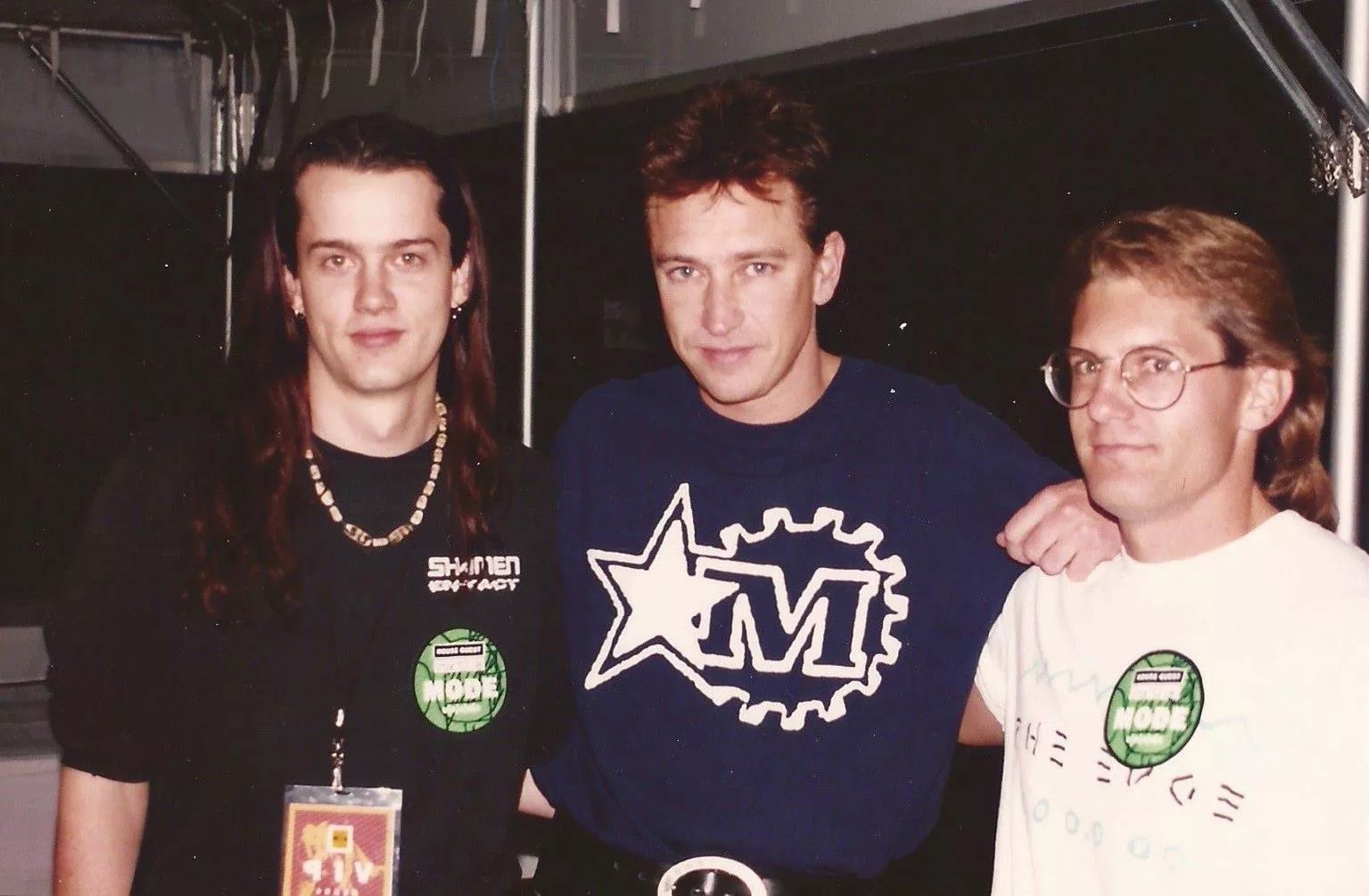
The Edge’s Christopher the Minister (left) and Gregg Paul (right) with Depeche Mode’s Andy Wilder in 1994.
John Clay
The Edge officially began broadcasting at 6 p.m. on Friday, January 15, 1993, at a mere 3,000 watts with Depeche Mode’s “Personal Jesus.”
Clay: We literally went from classical directly into Depeche Mode. It was supposed to be The Cure’s “Just Like Heaven, but I swapped it up from later in the hour and went with “Personal Jesus.” When I came into work early Monday, there were 50 people wandering around the front and lobby wanting to apply. Word spread quickly. By the end of the day, I’d interviewed hundreds of people and even more over the next few days. I can tell you the first hire: Christopher the Minister.
Minister: I came to Phoenix originally to work at KFMA, the FM alternative station [KUKQ’s Jonathan L.] started in Wickenburg. Jacobs Media called me and said, “Sit tight, we’re doing something in 10 days with this classical station.”
Clay: He’d dropped a tape off that, frankly, wasn’t good. But when we interviewed, the kid had this passion for the format coming out of him that bored holes through me. It was electric. He lived and loved the music.
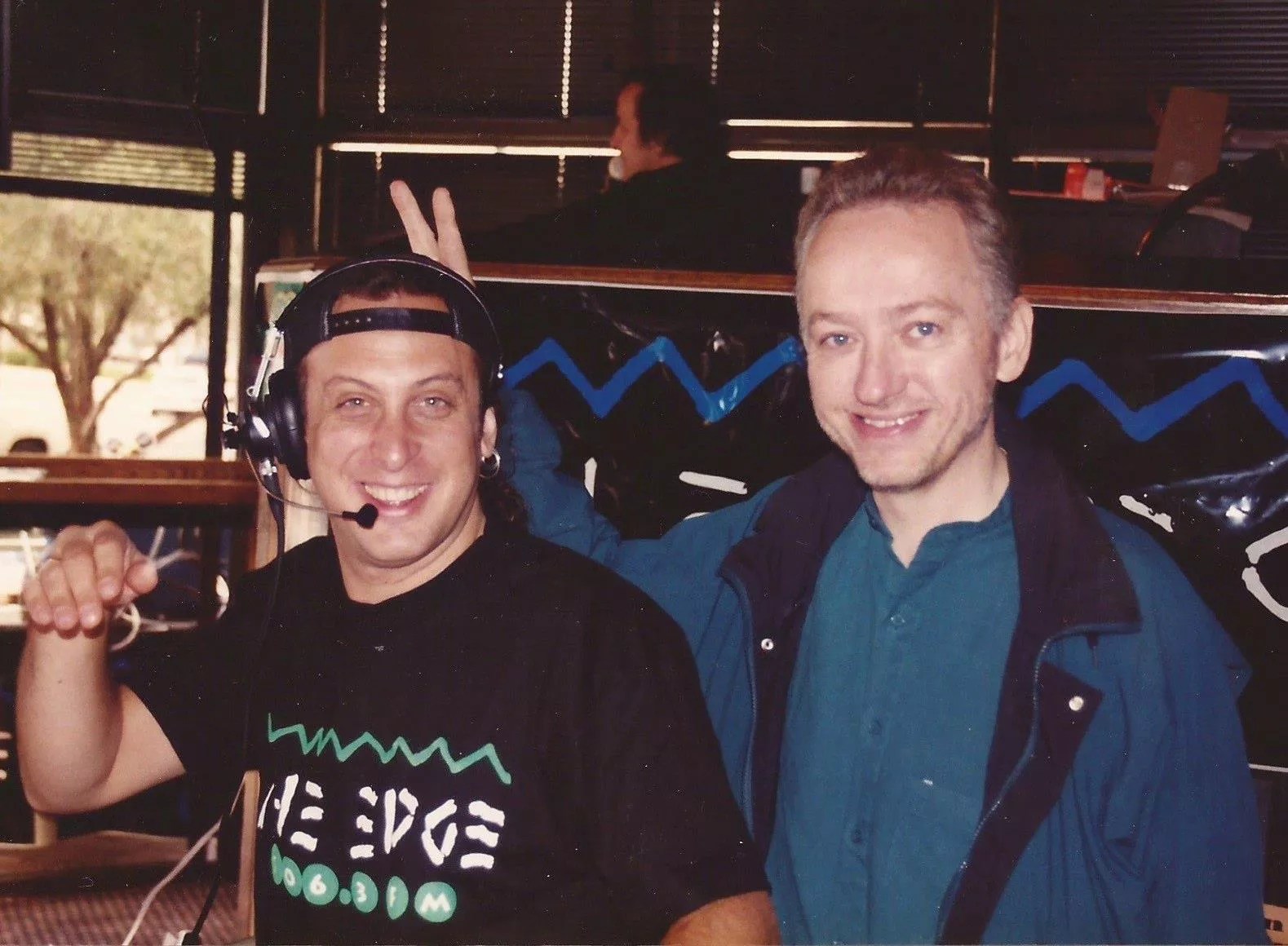
One of The Edge’s first morning jocks Willobee (left) in 1993 with then-program director John “Edison” Clay.
John Clay
Clay’s other early hires included Willobee, Shaun Vincent, and then-KFMA DJ Allison Strong.
Allison Strong, KEDJ DJ, 1993-1994: When John Clay asked to meet, I lived up in Wickenburg, and KFMA was about to sign off. I remember feeling I was in the right place at the right time. John was excited to be working in this format he loved. And he was good at it.
Willobee, KEDJ DJ, 1993-1995: I came in a couple of months after they signed on to do [Morning Breath Theater]. It was a three-person team: me, Mary Zeal was my co-host, and Commander Bill doing traffic. We didn’t do the morning zoo thing; it was really music focused and locally focused. We used to have trivia games on the air, lots of funny surveys, and some mindless shtick. Lots of giveaways with tons of concert tickets.
Minister: The studio was an old house, and we all squeezed in there with two other stations: Z-Rock [KZRX] and [AM sports-talk station KGME].
Larry Mac, KEDJ DJ, 1997-1998/2007-2008: I was working for Z-Rock, and we were literally in a closet next to The Edge’s studio.
Willobee: There were [two] double-wide trailers out back for promotions staff and salespeople. We referred to it as the “Modern Rock Trailer Park.” Other people who worked there called it “The Crackhouse.”
Clay: We used to refer to it as “Gun Point” or “Gunsville” because you could go out back at night and hear gunfire in the distance. It wasn’t a great part of town
Mac: I actually had a car stolen from the front of the station.
Shaun Vincent, KEDJ DJ, 1993-1996: I’d moved to the U.S. in ’89 [from England], so I played that up. It was the stereotypical English guy who knew all about the music, especially alternative, because a lot came from the U.K.: New Order, Joy Division, The Cure. We came from all over and created some great radio, even if we were on a smaller signal.
Locals noticed KEDJ, though, thanks to word of mouth and television commercials touting its “modern rock without the static,” a shot at competitors KUKQ and KFMA’s weaker signals.
Clay: It was competitive radio. It made sense to use that. [KFMA] hit the far, far fringe west of Phoenix. And KUKQ was AM, which hindered their ability to really penetrate. Although in retrospect, considering how weak our signal got into Tempe and Scottsdale, it makes me smile.
On May 15, 1993, KEDJ presented its first-ever Edge Fest, which brought Stone Temple Pilots, Goo Goo Dolls, Wailing Souls, 311, and thousands of fans to Chandler’s Compton Terrace.
Willobee: It was packed. Back then, we didn’t pay much for artists to perform because they did radio festivals to promote their records. Times change.
Gregg Paul, KEDJ promotions, 1993-1999: I’d started a day or two before and was working will call. I actually talked to Johnny Rzeznik from Goo Goo Dolls. He walked outside the gate, walking somebody out, and then [security] wouldn’t let him back in. I had to run over and say, “No, he’s with Goo Goo Dolls, and he’s supposed to be up on stage in the next few minutes.”
Minister: Me and Willobee introduced Stone Temple Pilots. It started raining really bad, and their manager wanted to pull them off stage. One of the DeLeo brothers said, “One more song. We just want to play!”
By August, KEDJ had a 2.4 share in the local ratings. It also became the Valley’s only alternative station after KUKQ switched formats. (KFMA had flipped to easy listening months earlier.)
Mac: Did The Edge kill the original KUKQ? Probably.
By 1994, The Edge had added new voices, including Jayn Sayd and longtimers Dead Air Dave and Robin Nash.
Dead Air Dave, KEDJ DJ, 1993-1998/1999-2011: I initially came in as production director to write and produce commercials and all the station’s [promos]. They had an opening on air and I went for it.
Robin Nash, KEDJ DJ, 1994-2012: I was going to ASU and John Clay called [campus station KASR] and said, “I’m looking for one female.” It was between me and another girl, but John liked me better. My shifts were crazy: Sundays from 2 to 6 a.m.
Jayn Sayd, morning show co-host, 1994-1995: Willobee was a character. Rough around the edges, but a really funny guy. He left, and Dead Air Dave and I hosted Coffee Ground Zero. It was a riff on the Fishbone song “Party At Ground Zero.” We’d play dumbass games with listeners and had an absolute blast.
Dave: It was really wonderful. When you’re on a rock station, the ratings show that your audience is mainly made up of men. And our goal was to create a show that made women feel just as engaged.
Sayd: One of the things that I love most about Christopher the Minister is he was just so passionate about the music. When there was a song that he thought that we should be playing, he would literally, he’s the first to tell you this, he would literally jump up and down on the table and just stomp his feet and be like, “We have to play this song.” And he would literally jump up and down on the table to make his point about a song.
Minister: We broke so many bands. We were the first ones to play Alanis Morrissette. We were the first ones to play, No Doubt. We were one of the first people in the country to play Portishead.
In July 1995, KEDJ began broadcasting top shock-jock Howard Stern’s nationally syndicated morning show and simulcasting on 100.3 [KZRX’s former frequency] in the east Valley. Ratings spiked.
Clay: It was a major deal. I was hesitant at first, based on his reputation. Then I called program directors who had him on. Every single one said, “It’s the best thing you can do. You won’t believe the ratings boost.”
Paul: Stern brought a whole new thing to the station.
Clay: Part of Howard’s contract says he’s indemnified from any legal action from the FCC or listeners for anything he said. [Any] FCC fines weren’t allowed to pass through the station to Stern; we were stuck [paying them.]
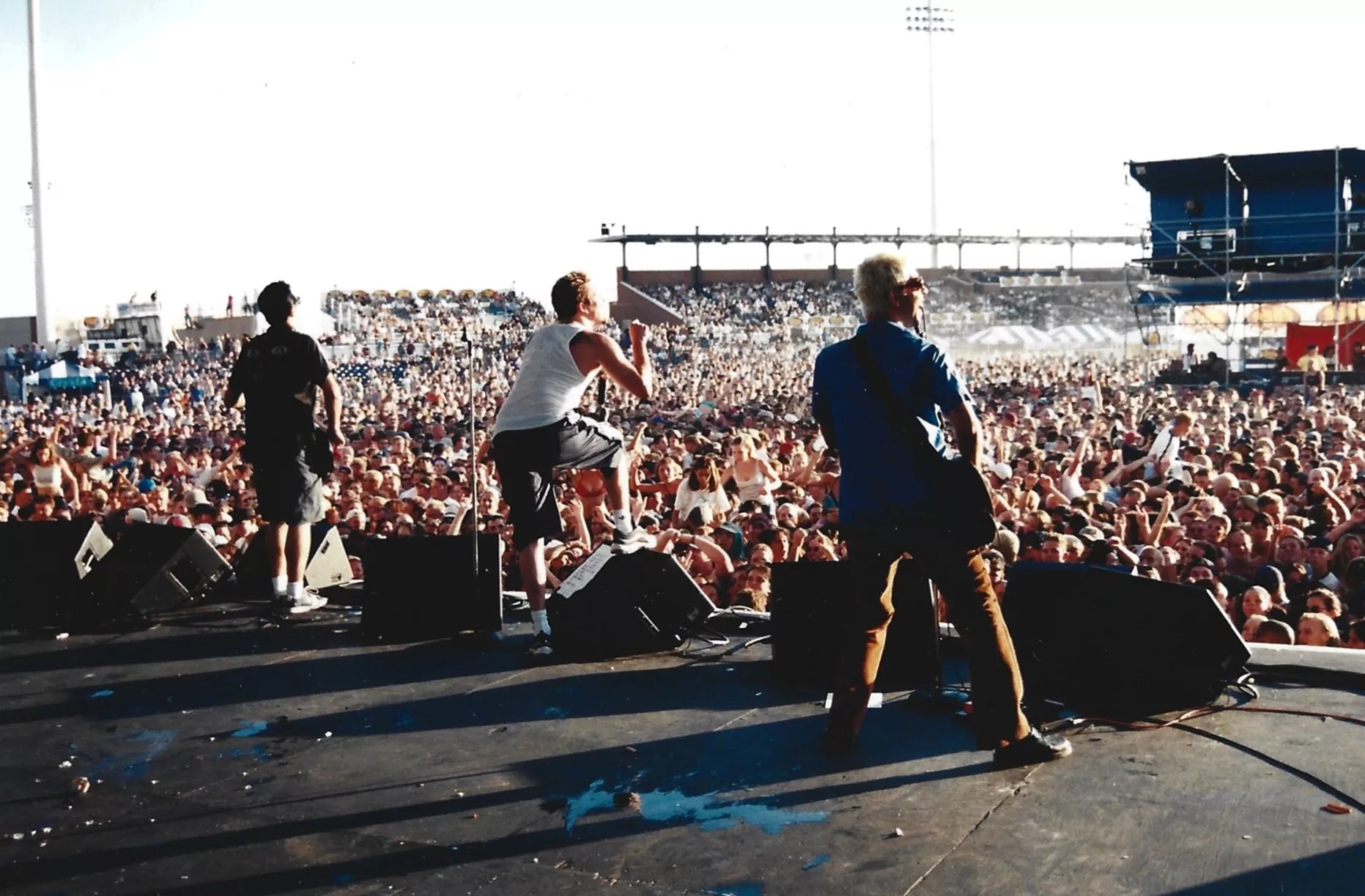
The main stage at an edition of That Damn Show that The Edge put on in the ’90s.
Robin Nash
That Damn Boom Period
The Edge’s parent company, Resource Media, made other big moves. The studio relocated to a high-rise at Seventh Street and Highland Avenue. In December 1995, it partnered with Seattle-based Century Management to form New Century Management. As is typical with ownership changes in radio, turnover in management followed.
Clay: When a new company comes in, they bring their own people. And their VP of programming wanted to promote the program director of their Seattle hip-hop station, which was Shellie Hart. [It] meant my departure.
Nash: Shellie came in, looked at me, and went, “What are you doing on nights? You need to be midday.” She gave me my big break and everything took off after that.
It wasn’t the only thing taking off. The Edge began its boom period. Its yearly festival, now rebranded as That Damn Show, had an ever-growing attendance, including 20,000-plus people in 1996.
Paul: We had That Damn Show, listeners had That Damn Card and put out That Damn Magazine. I remember [Michael “Smilin’ Marty” Whitney] on the cover of one.
Simone Yavar, Phoenix resident: That Damn Show was one of the first big music events I [attended].
Beef Vegan, KWSS DJ, 2008-2016: The Edge was my station in high school. They had this clubhouse vibe with the staff. It was everywhere, and you wanted to be a part of it.

The Edge’s Dead Air Dave (center) at now-defunct Scottsdale club Anderson’s Fifth Estate.
Larry Mac
It was everywhere and it was what you wanted to be a part of. They had this clubhouse vibe with the staff. KEDJ’s weekly “Cheap-Ass Drink Night” at now-defunct Scottsdale club Anderson’s Fifth Estate were also packed.
Nash: Every Tuesday it was this massive line down the block, everyone trying to get in. It was 25-cent drinks and we’d spin tunes.
Dave: Listeners came to every event. You’d see the same people every week there because it was like a ritual. People were like, we hang out with the Edge and they would come out and be like, you know, it’s like a house party, almost where everybody knew everyone and we all had a great time.
Nash: Back then, there was no other way to get music, right? Cell phones, iPhones didn’t exist. There was no YouTube or [Spotify]. So radio was so massive and people in town loved their music and their DJs and their favorite radio stations.
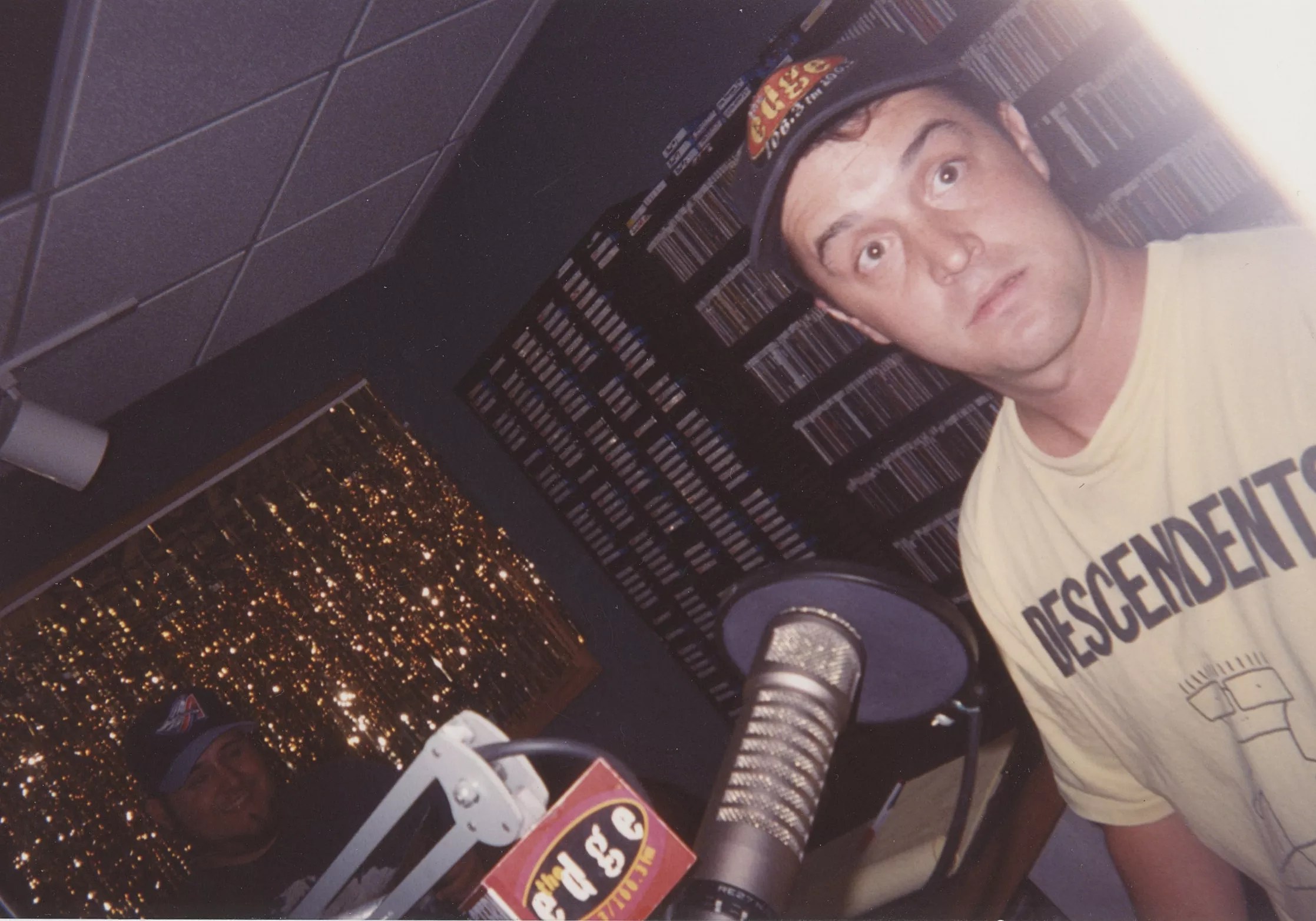
Ska-Punk host Craven Moorehead in The Edge’s studio.
Craven Moorehead
Skanks for the Memories
In 1997, Hart brainstormed with Larry Mac to create Ska-Punk for Sundays, which became the station’s longest-running and most beloved program.
Mac: I was doing promotions at Edge’s sister station KBUQ, and Shellie goes, “You want to do a specialty show over here?” We shot around ideas and the name Ska-Punk came up. The ska-punk genre had become a bigger thing around then.
Diana Welsch, former Valley resident: I used to tape songs off Ska-Punk. [It] gave me a big shove down the weird music rabbit hole.
Craven Moorehead, KEDJ DJ, 1998-2012: I started in promotions and went with Larry when he DJ’d around town. And we’d talk about our love for punk. When he left for KUPD, he told Shellie, “Give this kid a shot.”
Will Novak, Phoenix resident: I’d stay up late listening to Craven Moorehead. He and that show entirely shaped my musical tastes.
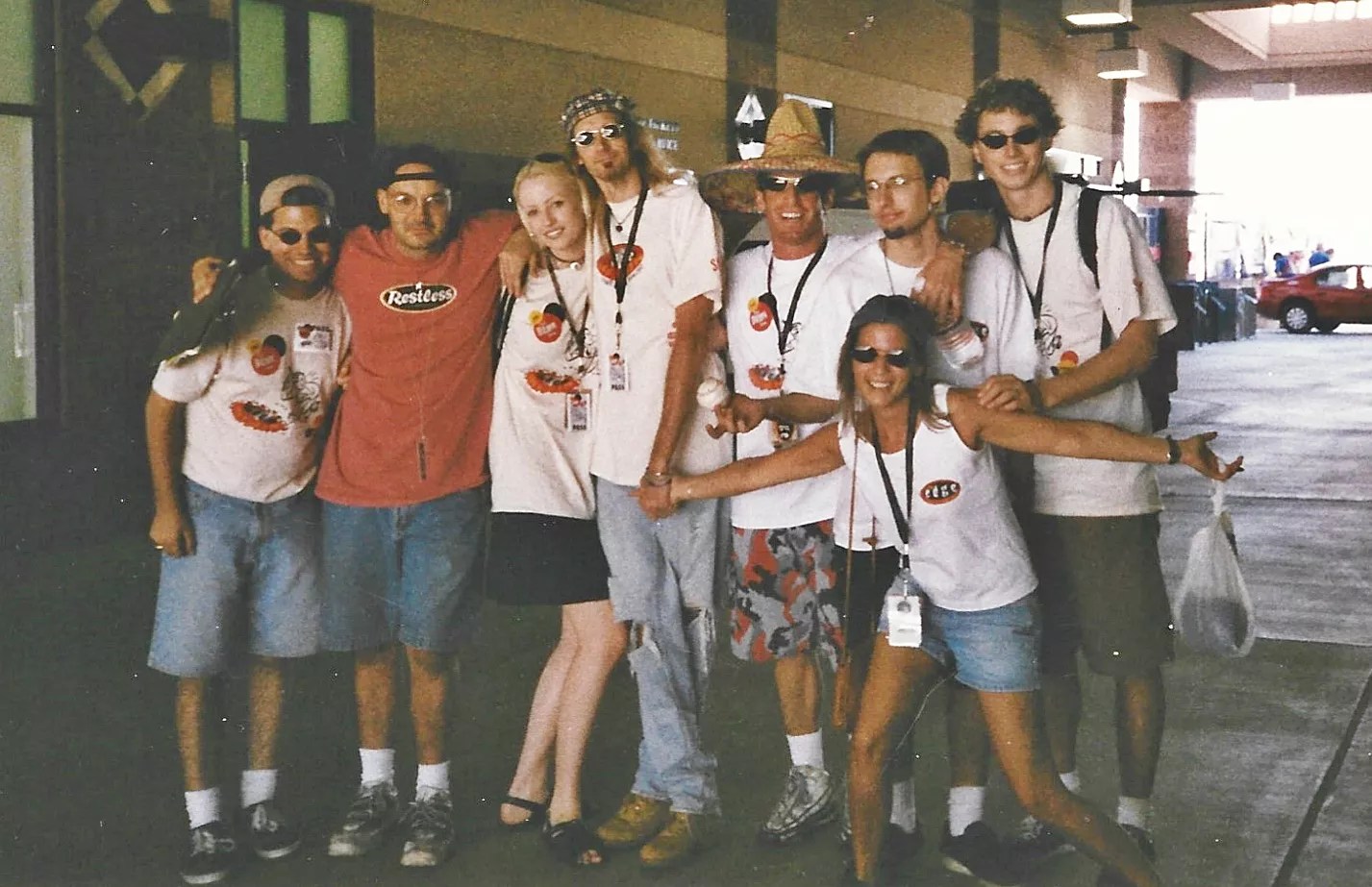
The staff of The Edge at Peoria Sports Complex during one of the station’s festivals, including Larry Mac (second from left), Dead Air Dave (center), the late “Pistol” Pete Kelly, Robin Nash (second from right), and “Smilin'” Marty Whitney (far right).
Robin Nash
Nu-Metal Madness
In September 1999, New Century Media sold to NYC-based Big City Radio for $22 million, and Hart departed KEDJ. Meanwhile, alternative radio had shifted toward rap-rock and nu-metal.
Paul Kriegler, program director, 1999 to 2001: About [three] months after starting with Big City Radio, the guy that hired me got fired. We ended up with another CEO who took over the radio group in December. They switched our L.A. sister stations to Spanish formats. It didn’t seem like things were going in the right direction.
Dave: Those days, you could hardly tell the difference between Edge and KUPD. We were playing those same artists, like Static X and Incubus.
Kriegler: It was an odd time for alternative. For the format to go off in a different direction and take on all this rock stuff, to me, was just gross. I held my nose and played it.
Moorehead: I never really got deep into nu-metal.
Kriegler: Howard Stern was good for a 20 share. The rest of the station? Not so much. The problem was getting that huge audience to listen at other times of the day.

A sticker from The Edge after the station moved to 103.9 FM in 2001.
Greg Blouch
Edge of Extinction
In September 2001, Big City Radio sold to Hispanic Broadcasting Corp., which planned to flip 106.3/100.3 to Latin music that Nov-ember. New program director Nancy Stevens reached out to Scott Fey, owner of Scottsdale-based New Planet Radio and Party 103.9. As negotiations stretched on, KEDJ inched towards extinction before an 11th-hour deal was struck on Halloween night.
Nash: Nancy somehow convinced him to switch formats and take the entire Edge staff. She saved us.
Dave: I grabbed a stack of CDs and my headphones. Robin was on the air, and I said, “Keep playing music. I’ll call you the minute I’m at the other studio.” I raced across town listening while she told people, “Don’t lose your Edge. Tune to 103.9 in a few minutes for Dead Air Dave.”
Nash: He flipped the switch, and Linkin Park was the first band played [on 103.9].
Joe Maier, Tempe resident: The next day, I hadn’t changed my [clock-radio], so when I woke up for school and heard Spanish radio, I went, “Oh yeah. It’s not at [106.3 FM] anymore.”
Howard Stern didn’t come with them, though, moving to KZON a month later.
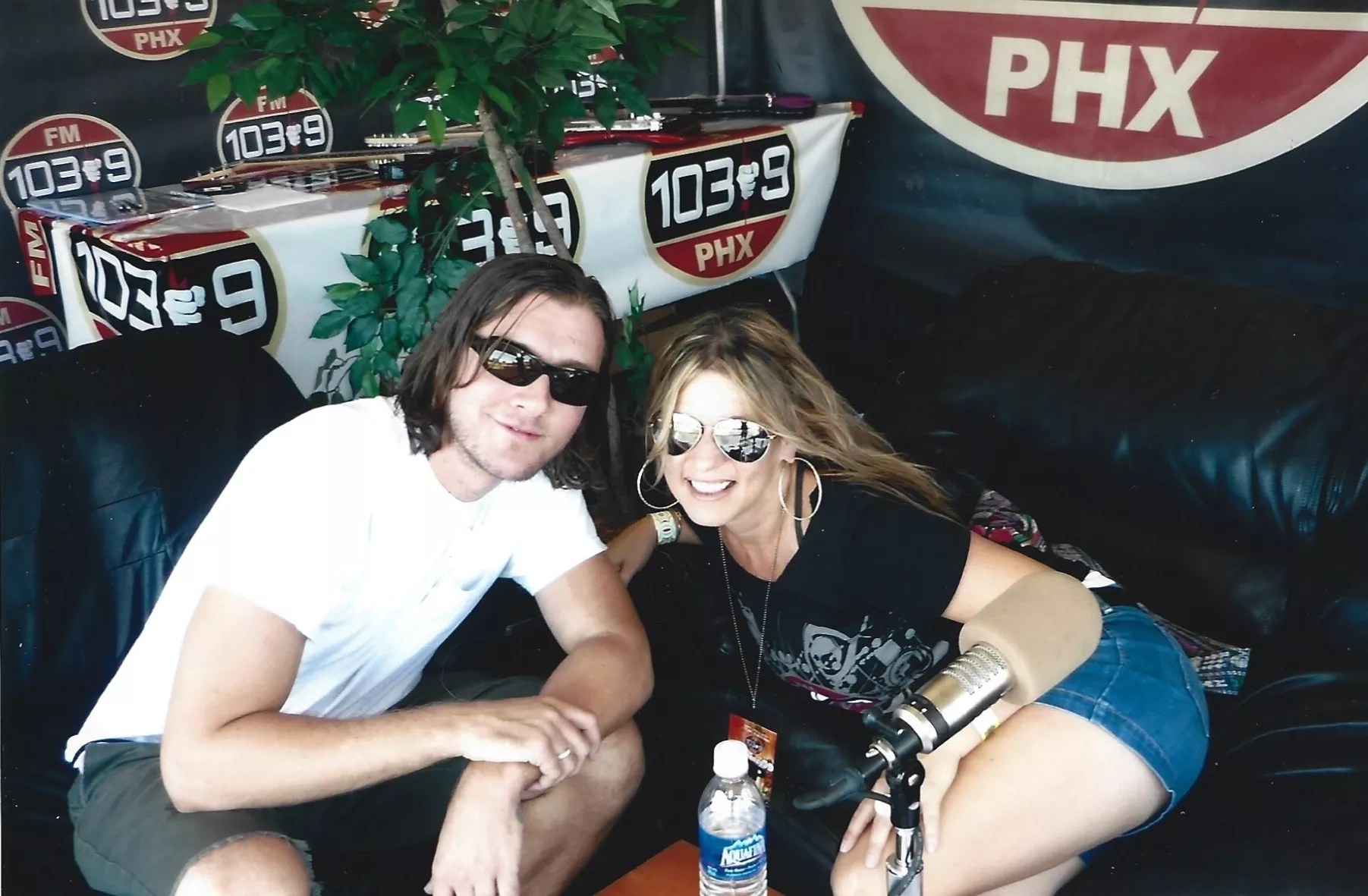
Robin Nash (right) with Authority Zero frontman Jason DeVore.
Robin Nash
Independent Days
With a new lease on life, The Edge attempted to forge a new direction. They also helped a few local bands break out. In 2001, the station played The Format on its Local Frequency show. The initial response earned the band regular airplay, resulting in a record deal.
Andy Hawk, KEDJ DJ (in 2002): I played one local song every night at midnight, and [asked] people whether they liked it or not. And [the] response was just overwhelmingly strong.
The same year, KEDJ began playing Mesa punks Authority Zero.
Jason DeVore, Authority Zero vocalist: The effect [The Edge] had for us was massive. Labels were hearing this local unsigned band getting massive airplay. It led to getting our first record deal with Lava/Atlantic Records.
The same year, The Edge also began releasing comps of the various in-studio “Acoustic Live and Rare” sets performed by both local and touring bands.
Maier: They have some really great stuff from local and national acts. Like Tegan and Sara, Story of the Year, MxPx, and The Format.
In 2002, The Edge tapped local sports talk radio personality Vince Marotta to co-host its morning show.
Vince Marotta, KEDJ morning show co-host, 2002-2007: I knew Nancy pretty well. She’d started a new morning show a few months earlier with a guy named Whip. They’d tried finding someone to pair with him and couldn’t find the right fit.
A year later, Whip was ditched in favor of Chuck Powell, Marotta’s former on-air partner at KGME. The show was rechristened The Morning Ritual and became a hit with Edge listeners.
Marc Young, KEDJ DJ/program director, 2003-2005/2009-2012: They had amazing chemistry.
Marotta: It was probably the funnest time of my career. We had so much creative freedom, and I find Chuck genuinely funny. He had all these ideas for sketches. It took a while to build our audience.
Maier: I remember listening to The Morning Ritual because of “Last Character Standing” [segments] with Chuck Powell doing voices for all those characters. It was hilarious.
Marotta: [“Last Character Standing”] was another Chuck creation. He is a prolific writer … and had all these ideas for sketches. I guess the best way to describe it was these characters he created in sketches that would be the radio equivalent of what you’d see on Saturday Night Live. So he would create, it started with the creation of two characters, and he would perform both of the sketches and then whichever was funnier, we’d leave it up to the audience to call in and decide who the winner was. And it lasted, I mean, that bit lasted like five-plus years, and the amount of characters he created over the years is mind-boggling.
The station itself was also attempting to increase listenership. Lower-than-expected ratings in 2003 caused Fey to push a new “Independent Radio” concept.
Young: Ratings dove even harder in the fall of 2003. We knew the station wasn’t healthy and needed major sweeping moves or else we’d go under. So Scott gave the programming department complete autonomy, which is rare. We stripped the station raw and had Scott’s voice on the air talking about how we were doing what people wanted from radio: good music, a variety of music, and not being corporately or chart-led.
The concept worked, as did bumping the station’s signal to 100,000 watts to compete with corporate stations. Within six months, it bounced back and gained on alt-rock competitor KZON. The Edge became a victim of its own success the following summer when New Planet Radio sold the station to Riviera Broadcast Group. Months later, Young was fired.
Young: When selling The Edge, they [mandated] new ownership had to preserve the format. They just didn’t say preserve the staff. They came in and decided to clean house and make everything sound corporate and rock.
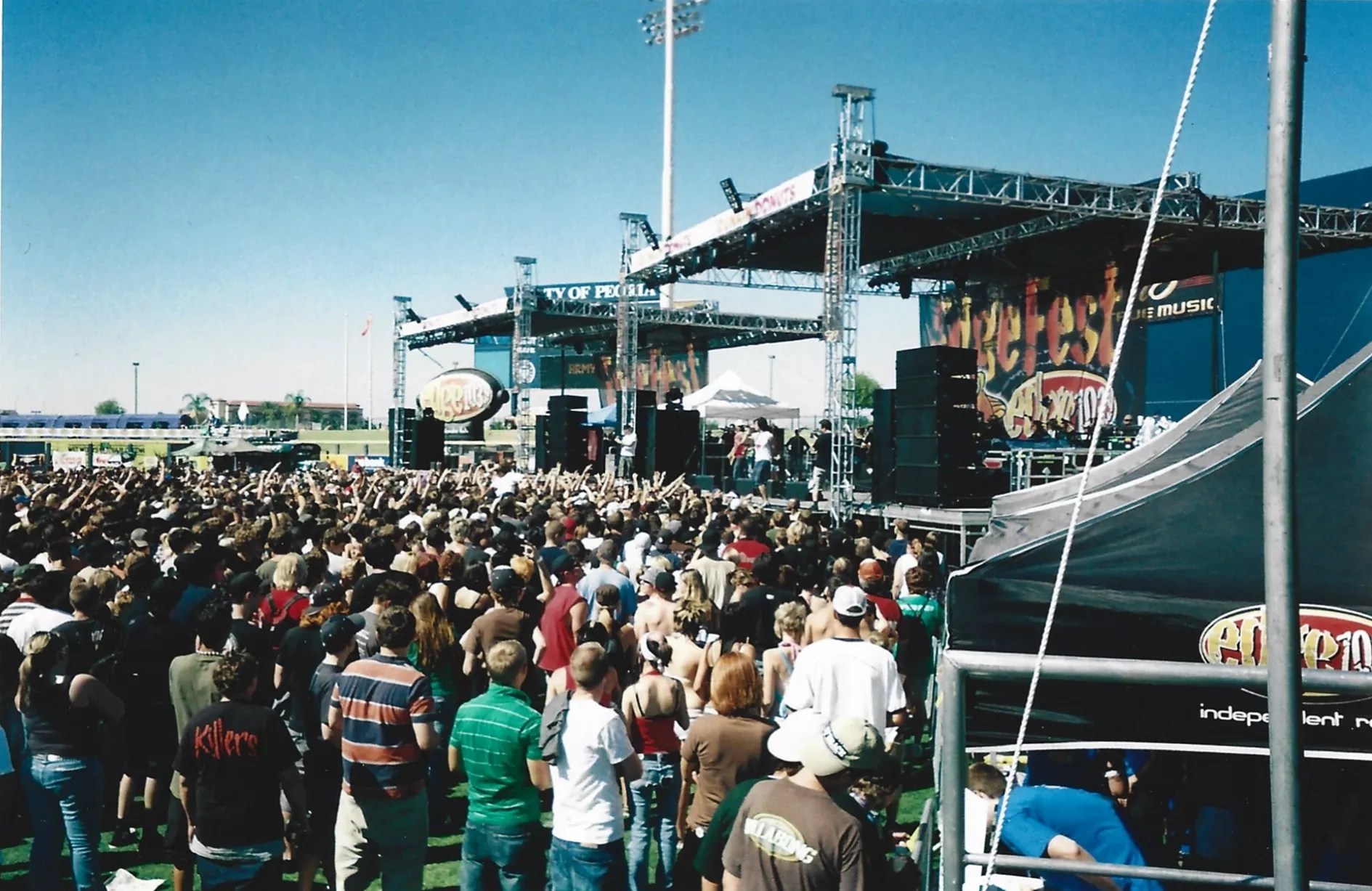
An Edgefest after the station moved to 103.9 FM.
Robin Nash
Let the Bad Times Roll
Riviera later purchased Power 92.3, moving it to 98.3 FM, and hired Bruce St. James as program director of both stations. Controversial decisions were made, including narrowing KEDJ’s playlist and nudging out Marotta.
Bruce St. James, program director, 2006-2008: My philosophy is addition by subtraction. It serves stations well. The mindset is, from a listener standpoint, you’re never hurt by songs you don’t play. You’re only hurt by songs you do play. If you play more songs people like, they’ll listen, and listen longer. We did music research. We tested songs with audiences. It wasn’t throwing darts at a board, going, “I like that song.” I’ve never run stations based on songs I liked.
Marotta: Riviera decided, “This is Chuck Powell’s creation.” So it went through these marketing changes and became Chuck Powell’s Morning Ritual. Around then, I’d gotten an offer from my old station. I told Bruce about it and he said. “You should take that offer.”
Marc Young: They were playing the national charts. You make a vanilla product, you get vanilla results. They lost massive amounts of money after buying it but kept spending.
St. James: The [Great Recession] didn’t help matters, because one of the first things a lot of businesses do when they’re circling the wagons trying to keep the lights on is they cut their advertising.
The Edge still had avid listeners and fans during that era, including future Alt AZ personality Monique “Mo!” Rodriguez.
Monique “Mo!” Rodriguez, Alt-AZ 93.3 midday host: I wanted to work there when I was younger because The Edge had an edge to it. I’d listen and I’d always sit with a cassette tape and my stereo and record breaks and songs from different people. And it’s just a mixtape I always loved and enjoyed. One of my favorite things I recorded was Craven Moorehead’s song, “Scottsdale Bars,” a parody of Flobots’ “Handlebars,” which ended up being one of my favorite songs for the longest time.
Moorehead: It came out of one of my normal gigs at [The Edge], doing production, radio imaging, and finding funny ways to promote the station between songs. Our program director at the time had an instrumental [version] of the Flobots song and said, “See if you could do something with this.” It started off as a 10-second thing, like something you’d normally hear between songs on any station. Then, Tim Virgin, our music director at the time, called me and asked, “Did you do this? You should make a whole song.” I thought it would be funny, so I went into my home studio, and came up with all the douchey things about Scottsdale I could think of in a couple of hours.
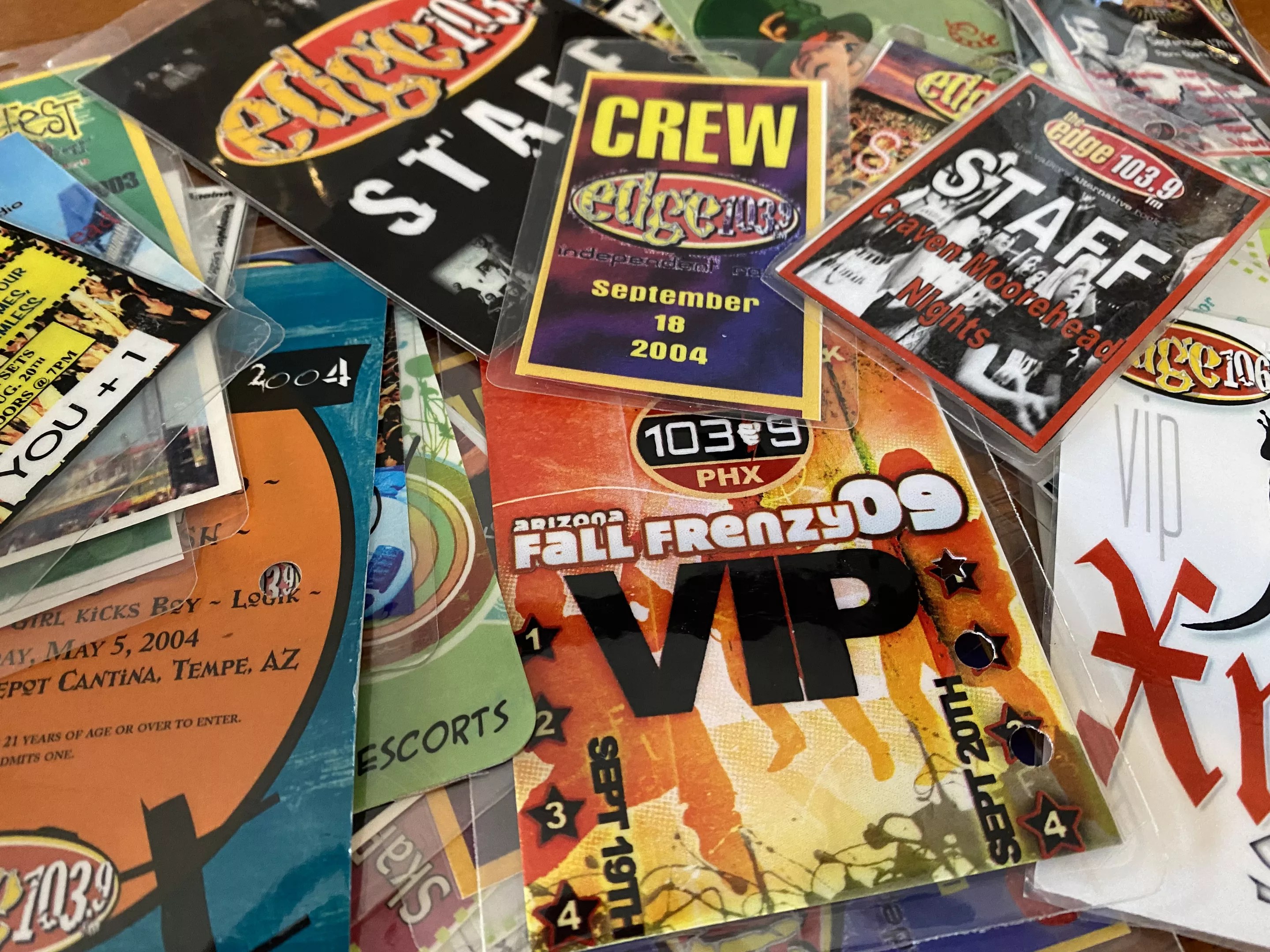
Various staff badges from The Edge’s concerts over the years.
Benjamin Leatherman
Losing The Edge
In 2009, the banks backing Riviera took possession of their stations, downsized, and rehired Young to rebuild again. Five months later, Phoenix-based Sun City Communications bought The Edge and rebranded it as X103.9.
Young: The Edge was declining for four to five years. They wanted to splash the market with a new name. Then it became, “Go back to what you were doing in 2005. Here’s your expanded [music] library.” So you start cooking. It takes three months to get ratings and let the market understand what you’re doing. We were starting to cook when we got acquired again.
Riviera Broadcasting had been revived by a private equity firm and purchased Sun City Communications, bringing in new management and another round of consultants and adjustments.
Young: Then you start over again. It was cooking pretty well. We retooled it, and we were doing pretty good again. Then other chaotic things came in into play.
Namely, adding legendary Valley rock jock and morning host Dave Pratt in November 2011. The move caused a significant backlash against the station by Pratt’s detractors and was its death knell.
Young: It was an attempt to expand our ratings. It wasn’t working for the listeners. So, why would the listeners work for him? They abandoned us in droves.
As a result, X103.9 officially flipped to classic rock on January 12, 2012, becoming My103.9. Fittingly, the final song played was Depeche Mode’s “Personal Jesus.”
Nash: What’s funny is myself, Craven, and Gadger were the three last DJs that remained through all the changes.
Moorehead: The Edge is one of those things you look back on, that, in the moment, you don’t realize how great it is until it’s gone. It was a special time for us and the fans and bands of the station. It was all one [shared] thing.
Note: Some quotes have been condensed for brevity and clarity.